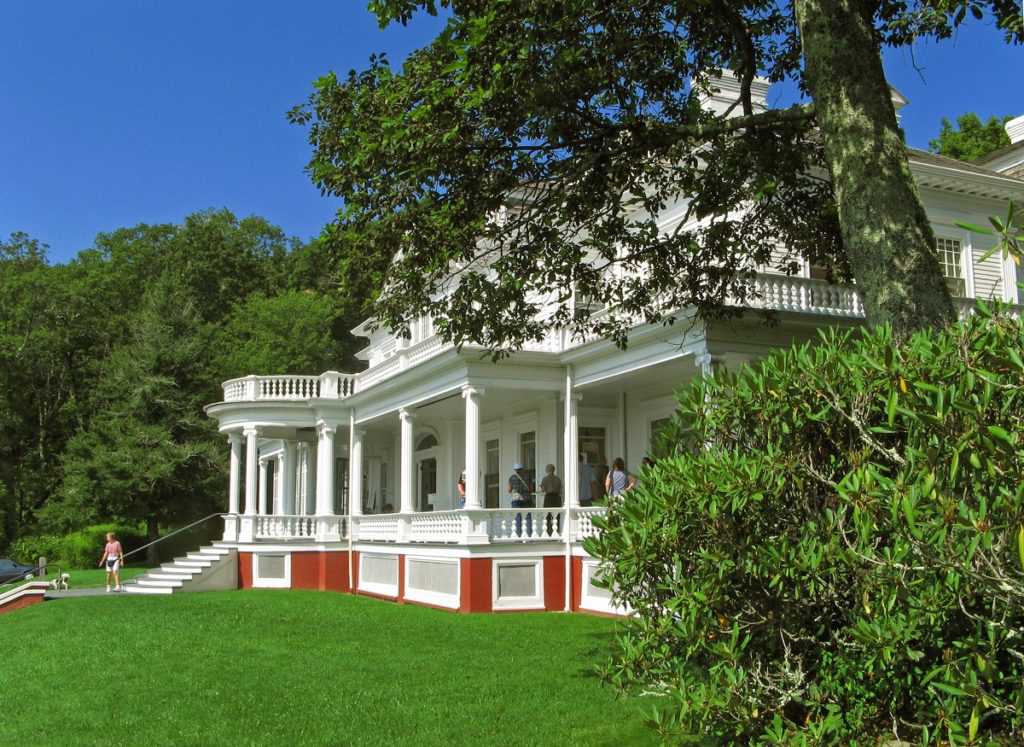Flat Top Manor towers over a rolling mountain view where carriage trails, like dusty snakes, wind through trees and around a scenic lake below. The green-framed screen door on the porch, reluctant from age and weather, creaks loudly as visitors pour in and out of the house. Allow yourself to be swept into the crowd and you’ll enter one of the Blue Ridge Parkway’s most popular historical sites, also known as Moses Cone Park.
The manor house hosts an average of 900 to 1,000 visitors per day during October, its busiest month of the year. Some people never go inside the home; the park attracts horseback riders, hikers, runners and tourists who come to take in views on the old carriage trails while the trees blaze with fall color.
Dan and Fay Ross, a couple from Philadelphia, Pennsylvania, read an article about Moses Cone Manor in 2002 in the Philadelphia Inquirer. Fay Ross said she saved the article and ever since then the couple wanted to visit the property.
“Without all these people, sitting and looking out over the lake from the rocking chairs is lovely, I imagine,” Fay Ross said. “It’s beautiful, absolutely beautiful.”
Completed in 1901, the manor served as the summer home of Moses and Bertha Cone: philanthropists, business and community leaders, and naturalists. A retreat from the heat and sickness of summer in Baltimore, Maryland, the house and surrounding property offered plenty of breathing room to them, their friends and extended family – 3,650 acres to be exact.
“He didn’t just treat it as a vacation, he improved so many of the surroundings,” said Rita White, president of Blowing Rock Historical Society. “He was so interested in conservation and I don’t think he came here with that in mind, but I think he fell in love and it grew from there.”
Forty-five separate transactions in Watauga and Caldwell County deed books showed that Moses purchased the land for $29,000 total — roughly $7.95 per acre. Elizabeth Faison, a national park ranger, said that while the estate was not as ordinate as the Biltmore in Asheville, its construction displayed comfort and status. With sprawling apple orchards, herds of cattle and sheep, lakes stocked with trout, and perfectly groomed carriage trails, Moses and Bertha Cone wanted their property to display their social status and hobbies.
The property had 57 buildings in total, including a one-lane bowling alley and the county’s first permanent school. Chuck Robertson, a national park ranger, said that about 30 families lived and worked permanently on the estate, either on the farm or in the house. Seven to 10 black servants also traveled from Baltimore each summer with the Cone family to work as maids, drivers and butlers. Faison said the staff were generally treated well.
“Mrs. Cone was always concerned about the physical and spiritual well-being of their staff,” Faison said. “These were people who gave back into the community.”
The Cones didn’t have much time to enjoy their home together. Moses Cone died of a pulmonary edema in 1908 when he was 51 years old. Robertson said that Bertha Cone, who outlived him by 39 years, never truly recovered from his death. Since the couple did not have children, she brought family from both sides to stay with her at the estate. Bertha Cone died in 1947 and left the land to Moses’ namesake hospital in Greensboro, North Carolina. The hospital gave the land to the National Park Service in 1949.
Story by Macon Atkinson, A&E Reporter
Photo courtesy of the Blue Ridge Parkway Foundation
Featured photo caption: The Moses H. Cone Manor, a 23-room mansion. The estate is a popular Blue Ridge Parkway attraction with hiking trails and horseback riding.

